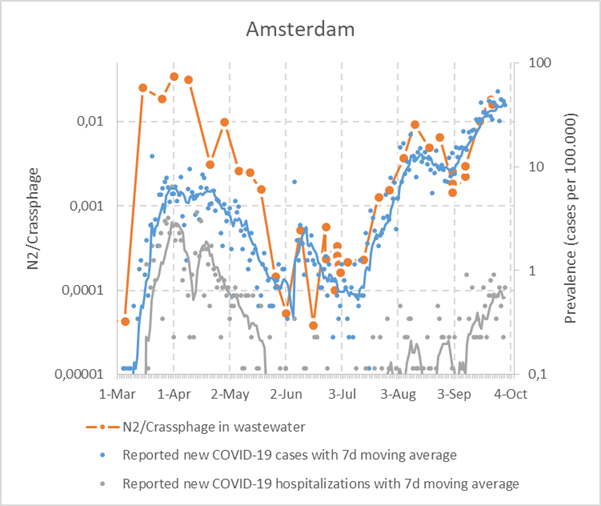The KWR microbiologists have extensively evaluated and improved their research methods for the surveillance of the coronavirus genetic material in wastewater. Up until now, the analyses have only included concentrations of SARS-Cov-2 RNA per millilitre, but from now on we will be taking into consideration the ‘concentration of SARS-Cov-2 RNA per concentration of human faecal material’. This method takes into account the days when rainfall dilutes the SARS-Cov-2 RNA concentration. In addition, because the RIVM has geared up the national wastewater surveillance programme, KWR has since 3 September only continued with the monitoring the wastewater in Amsterdam, Utrecht and Rotterdam.
In the graphs we published up until 20 August, we always presented the measured SARS-CoV-2 RNA concentrations in wastewater along the y axis. Since a heavy rainfall will dilute the wastewater, the measured SARS-CoV-2 RNA concentrations on rainy days are lower than they are on dry days. This means that the SARS-CoV-2 RNA concentrations need to be ‘normalised’ for the dilution of the total concentration of human faecal material in the sewer over the monitoring period (24 hours). Gertjan Medema, head researcher on the KWR corona team, decided to analyse the samples not only for SARS-CoV-2 but also for ‘CrAssphage’. CrAssphage is a bacterial virus that is very specific to human faecal material and is present in high concentrations.
Measurement correction with ‘CrAssphage’
Medema: ‘The proportion of human faecal material in the sewage can vary from day to day. When it rains, the rainwater dilutes the wastewater and the proportion of human faecal material decreases, and so too does the SARS-CoV-2 concentration. To properly evaluate the time history, such dilution must be corrected (normalised). We do this by measuring the proportion of human faecal material in wastewater (using CrAssphage) in parallel with the SARS-CoV-2 concentrations. By dividing the SARS-CoV-2 concentration by the CrAssphage concentration we get the concentration of SARS-CoV-2 per concentration of human faecal material in the wastewater.’
Early warning
What does the sewage tell us? The concentrations of SARS-CoV-2 clearly show that the circulation of the virus is again increasing. The difference between the concentration of SARS-CoV-2 RNA in municipal wastewater and the number of people tested positive for COVID-19 is now smaller than it was during the first wave. This is because a lot more people are being tested now than in March and April. The orange and blue curves are therefore also closer to each other than they were in March and April.
The early warning from the sewage surveillance is therefore less evident than it was in advance of the first wave; nonetheless, in Amersfoort, Utrecht and Tilburg the SARS-CoV-2 concentrations in the wastewater have also increased during the second wave ahead of the number of reports (i.e., positive test results). Gertjan Medema: ‘The early-warning function that the sewage still has, benefits from more frequent analysis of the wastewater: several times a week for big cities or hotspots.’
Graphs for Amsterdam and Utrecht
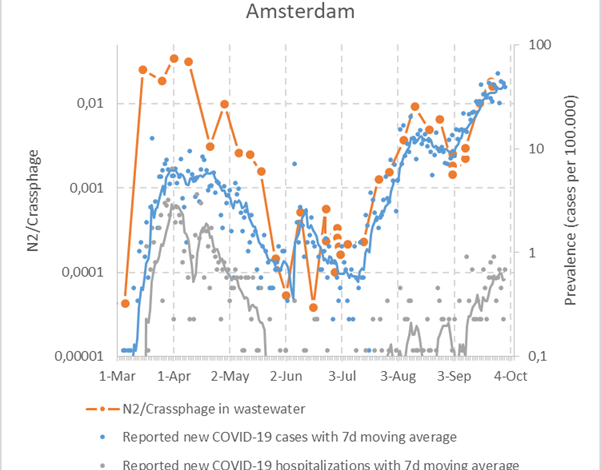
The corrected SARS-CoV-2 concentration in wastewater (orange), the number of infections reported to the Municipal Health Authority (blue), and the number of hospitalizations (grey) in Amsterdam.
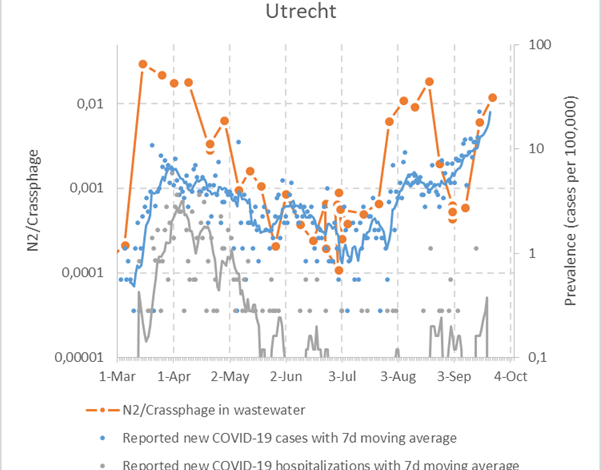
The corrected SARS-CoV-2 concentration in wastewater (orange), the number of infections reported to the Municipal Health Authority (blue), and the number of hospitalizations (grey) in Utrecht.
Filters
In August we had a supply problem concerning the filters we use to concentrate the viruses from the wastewater. In that month we had to conduct measurements with a replacement filter, which produced a lower virus yield (see graph below for Utrecht). That applied to both SARS-CoV-2 (yellow curve) and to CrAssphage. This was corrected by the normalisation (green curve).
Apart from the differences due to the different filters, the graph below also makes it clear that the uncorrected measurements – and thus the trends – are not influenced that much by the dilution of the wastewater.
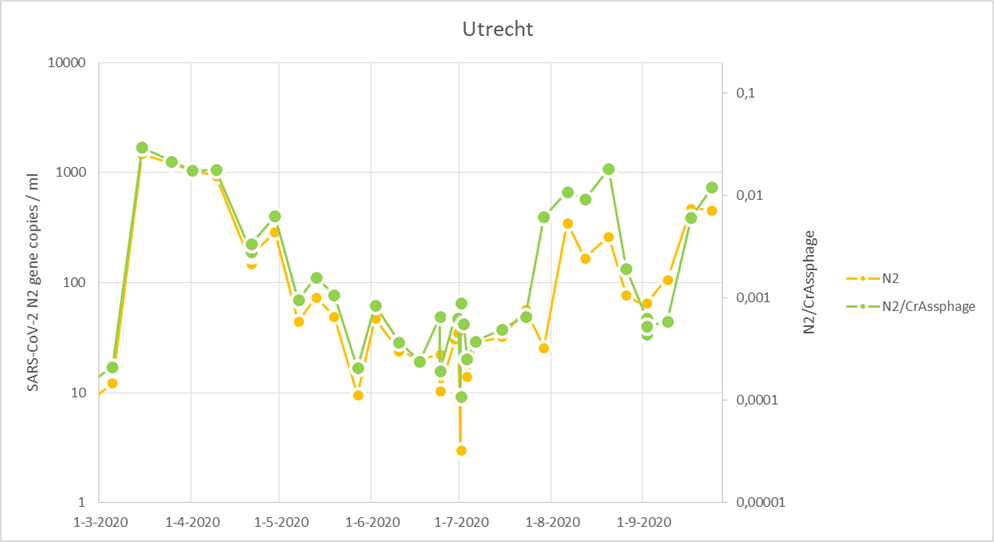
The graph of the wastewater measurements in Utrecht clearly shows the results of the two measurement methods: uncorrected (yellow: only N2 coronavirus gene copies per millilitre) and normalised (green: N2 divided by CrAssphage). The differences are not great, apart from the period in which KWR had to make use of replacement filters because of supply problems.
Monitoring specific populations
The sampling of smaller areas, such as city districts, neighbourhoods or even hospitals, also means that the Municipal Health Authority (GGD) can intervene on the basis of the wastewater data in a more targeted manner. Medema: ‘The sewage after all indicates the infection of an entire population (a city district or hospital), and not that of a relatively small number of citizens who experience symptoms, get themselves tested, and receive positive results. The sewage also reveals all those people who are infected but have not come forward.’
Since August, the KWR corona team has been analysing the SARS-CoV-2 RNA concentrations in the sewer system in city districts and neighbourhoods of Rotterdam. We do this within the TKI framework, together with Erasmus MC, GGD and doctors’ surgeries in Rotterdam, Water Authorities, Partners4UrbanWater, RoyalHaskoning-DHV, IMD and AQUON. The graphs for Rotterdam will henceforth be published via the project.
Graphs for other locations
Because the RIVM has geared up the national sewage surveillance programme, as of 3 September we ceased monitoring the wastewater in Amersfoort, The Hague, Tilburg, Apeldoorn, Franeker and Terschelling. Below we present our last graphs for these locations.
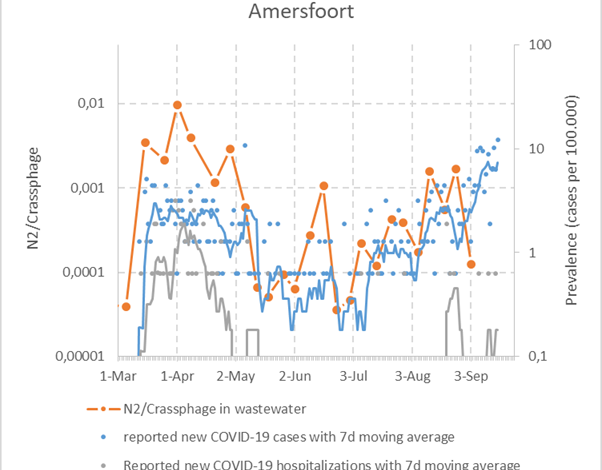
The corrected SARS-CoV-2 concentration in wastewater (orange), the number of infections reported to the Municipal Health Authority (blue), and the number of hospitalizations (grey) in Amersfoort.
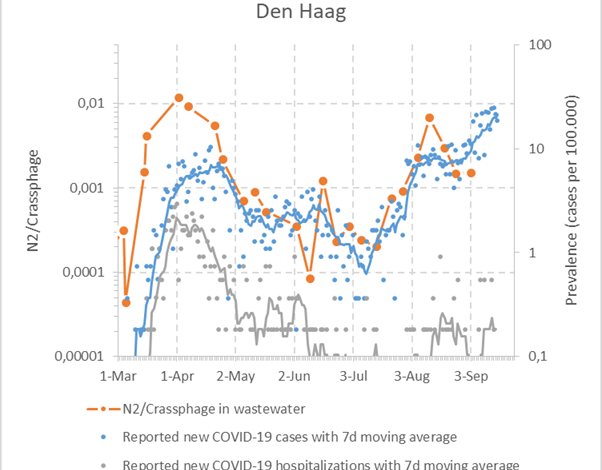
The corrected SARS-CoV-2 concentration in wastewater (orange), the number of infections reported to the Municipal Health Authority (blue), and the number of hospitalizations (grey) in The Hague.
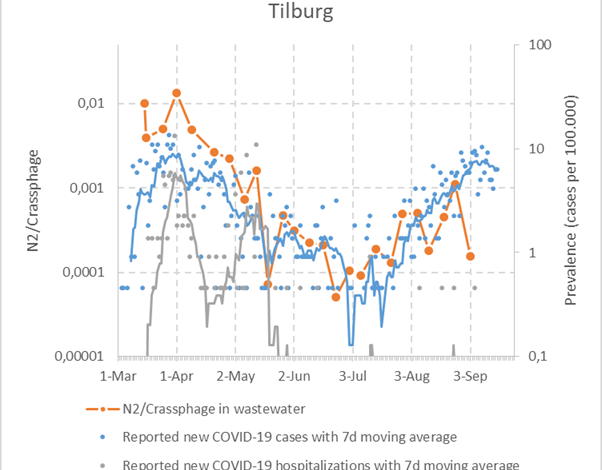
The corrected SARS-CoV-2 concentration in wastewater (orange), the number of infections reported to the Municipal Health Authority (blue), and the number of hospitalizations (grey) in Tilburg.
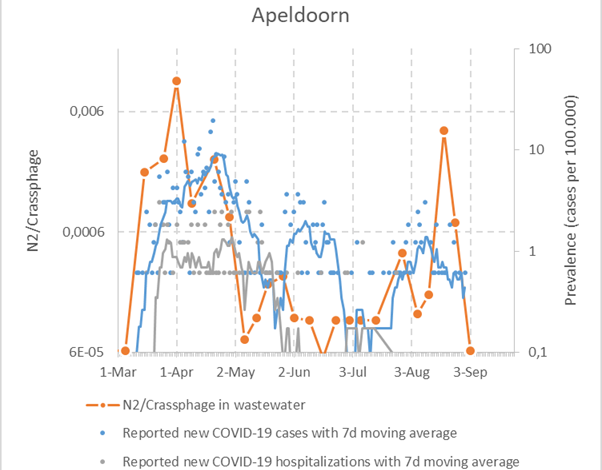
The corrected SARS-CoV-2 concentration in wastewater (orange), the number of infections reported to the Municipal Health Authority (blue), and the number of hospitalizations (grey) in Apeldoorn.
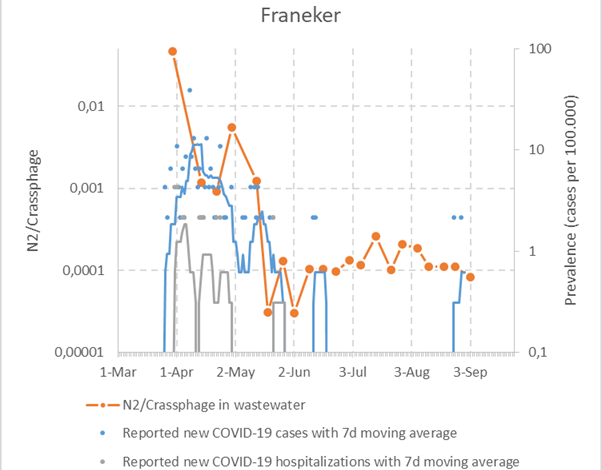
The corrected SARS-CoV-2 concentration in wastewater (orange), the number of infections reported to the Municipal Health Authority (blue), and the number of hospitalizations (grey) in Franeker.
In Terschelling there are too few patients, hospitalizations or wastewater positives for a graph.
National corona dashboard
For the current figures we refer to the ‘Covid-19 Nationale SARS-CoV-2 Afvalwatersurveillance’ website of RIVM.
